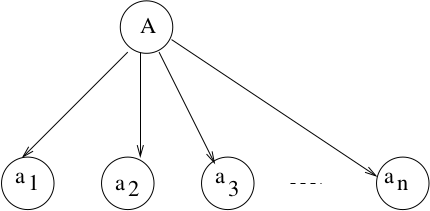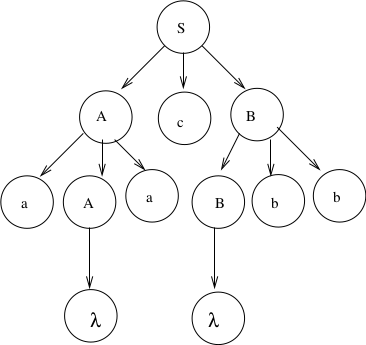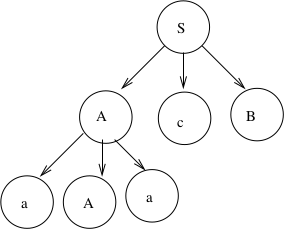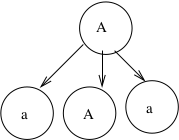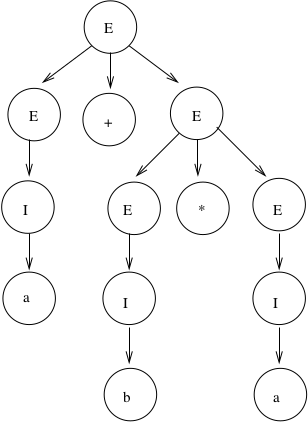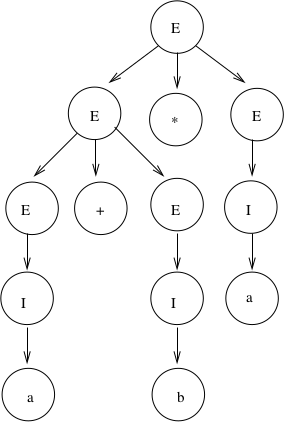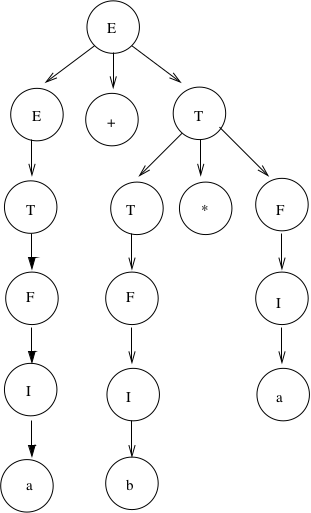Context-Free Languages¶
1. Context-Free Languages¶
Examples of regular languages:
- keywords in a programming language
- names of identifiers
- integers
- a finite list of miscillaneous symbols: = ;
Not Regular languages:
- expressions: \(((a + b) - c)\)
- block structures (\(\{\}\) in Java/C++ and
begin...endin Pascal)
We know that not all languages are not regular, since we've proved some are not.
Now we will look at a class of languages that is larger than the regular languages, and more powerful: Context-free languages.
Definition: A grammar \(G = (V, T, S, P)\) is context-free if all productions are of the form
\(A \rightarrow x\)
Definition: \(L\) is a context-free language (CFL) iff \(\exists\) context-free grammar (CFG) \(G\) such that \(L = L(G)\).
Example 1
Note
We have seen this before! Its not regular!
Definition: A linear grammar has at most one variable on the right hand side of any production. Thus, right linear and left linear grammars are also linear grammars.
So, this is a linear grammar.
Example 2
Example 3
This grammar is not a linear grammar, as there is a choice of which variable to replace.
To write an algorithm to perform replacements, we need some order. We will see this when we look at parsing algorithms.
Definition: Leftmost derivation: in each step of a derivation, replace the leftmost variable. (See derivation 1 above).
Definition: Rightmost derivation: in each step of a derivation, replace the rightmost variable. (See derivation 2 above).
Derivation Trees (also known as "parse trees"): A derivation tree represents a derivation, but does not show the order in which productions were applied.
Example 4
A derivation tree for \(G = (V, T, S, P)\):
- root is labeled \(S\)
- leaves are labeled \(x\), where \(x \in T \cup \{\lambda\}\)
- nonleaf vertices labeled \(A, A \in V\)
- For rule \(A \rightarrow a_1a_2a_3\ldots a_n\), where \(A \in V, a_i \in (T \cup V \cup \{\lambda\})\),
Example 5
NOTE: Derivation trees do not denote the order variables are replaced! We could however get a leftmost or rightmost derivation easily from looking at the tree.
Definitions: Partial derivation tree - subtree of derivation tree.
If partial derivation tree has root \(S\) then it represents a sentential form.
Leaves from left to right in a derivation tree form the yield of the tree.
If \(w\) is the yield of a derivation tree, then it must be that \(w \in L(G)\).
The yield for the example above is \(aacbb\).
Example 6
A partial derivation tree that has root S:
The yield of this example is \(aAacB\) (which is a sentential form).
Membership: Given CFG \(G\) and string \(w \in \Sigma^*\), is \(w \in L(G)\)?
If we can find a derivation of \(w\), then we would know that \(w\) is in \(L(G)\).
Why would anybody want to do this? \(G =\) Java, \(w =\) Java program. Is \(w\) a syntactically correct program? This is (part of) what a compiler does. You write a program, you compile it, and the compiler finds all your syntax mistakes. (It also "translates" the program into "bytecode" to be executed. We won't talk much about that aspect of compilers in this class.)
Example 8
Exhaustive Search Algorithm
If you were to run this in JFLAP, it takes a LONG time, but eventually accepts... The problem is that this approach is rather inefficient since it is using an exhaustive search for all ways of expanding from the start symbol.
For all \(i = 1, 2, 3, \ldots\)Examine all sentential forms yielded by \(i\) substitutions
Example 9
Is \(abbab \in L(G)\)?
Note: Will we find \(w\)? How long will it take? If we just do leftmost derivations, then for \(i = 2\), 8 of length 2.
When \(i = 6\) we will find the derivation of \(w\).
\(S \Rightarrow SS \Rightarrow aSaS \Rightarrow aSSaS \Rightarrow abSaS \Rightarrow abba \Rightarrow abbab\)
Question: What happens if \(w\) is not in \(L(G)\)? When do we stop the loop in the algorithm and know for sure that \(w\) is not going to be derived? \(S \Rightarrow SS ... \Rightarrow SSSSSSSSSS ... \Rightarrow S\)
We cannot determine that \(baaba\) is not in \(L(G)\).
Note
What happens if you run this in JFLAP?
We want to consider special forms of context free grammars such that we can determine when strings are or are not in the language. Easy to write a context-free grammar and then convert it into a special form, it will be easier to test membership.
Theorem 1
Theorem: If CFG \(G\) does not contain rules of the form
\(A \rightarrow \lambda\)\(A \rightarrow B\)
where \(A, B \in V\), then we can determine if \(w \in L(G)\) or if \(w \not\in L(G)\).
Proof: Consider
1. length of sentential forms2. number of terminal symbols in a sentential form
Either 1 or 2 increases with each derivation.
Derivation of string \(w\) in \(L(G)\) takes \(\le 2|w|\) times through loop in the exhaustive algorithm.
Thus, if there are \(> 2|w|\) times through loop, then \(w \not\in L(G)\).
Example 10
Let \(L_2 = L_1 - \{\lambda\}\). \(L_2 = L(G)\) where \(G\) is:
\(S \rightarrow SS\ |\ aa\ |\ aSa\ |\ b\)
NOTE that this grammar is in the correct form for the theorem.
Show \(baaba \not\in L(G)\).
With each substitution, either there is at least one more terminal or the length of the sentential form has increased.
So after we process the loop for \(i = 10\), we can conclude that \(baaba\) is not in \(L(G)\).
Next chapter, we will learn methods for taking a grammar and transforming it into an equivalent (or almost equivalent) grammar. We will see that some ways of writing a grammar for a language are better than others, in terms of our ability to write practical algorithms for solving the membership problem. For now, here is another form that will make membership testing easier.
Definition: Simple grammar (or s-grammar) has all productions of the form:
\(A \rightarrow ax\)
where \(A \in V\), \(a \in T\), and \(x \in V^*\) AND any pair \((A, a)\) can occur in at most one rule.
If you use the exhaustive search method to ask if \(w \in L(G)\), where \(G\) is an s-grammar, the number of terminals increases with each step.
1.1. Ambiguity¶
Definition: A CFG \(G\) is ambiguous if \(\exists\) some \(w \in L(G)\) which has two distinct derivation trees.
Example 11
Expression grammar
\(G = (\{E, I\}, \{a, b, +, *, (, )\}, E, P), P =\)
\(E \rightarrow E+E\ |\ E*E\ |\ (E)\ |\ I\)\(I \rightarrow a\ |\ b\)
Derivation of \(a+b*a\) is:
\(E \Rightarrow \underline{E}+E \Rightarrow \underline{I}+E \Rightarrow a+\underline{E} \Rightarrow a+\underline{E}*E \Rightarrow a+\underline{I}*E \Rightarrow a+b*\underline{E} \Rightarrow a+b*\underline{I} \Rightarrow a+b*a\)
Corresponding derivation tree is:
Derivation trees of expressions are evaluated bottom up. So if \(a = 2\) and \(b = 4\), then the "result" of this expression is \(2+(4*2) = 10\).
Another derivation of \(a+b*a\) is:
\(E \Rightarrow \underline{E}*E \Rightarrow \underline{E}+E*E \Rightarrow \underline{I}+E*E \Rightarrow a+\underline{E}*E \Rightarrow a+\underline{I}*E \Rightarrow a+b*\underline{E} \Rightarrow a+b*\underline{I} \Rightarrow a+b*a\)
Corresponding derivation tree is:
If \(a = 2\) and \(b = 4\), then the "result" of this expression is \((2+4)*2 = 12\).
There are two distinct derivation trees for the same string. Thus the grammar is ambiguous. The string can have different meanings depending on which way it is interpreted.
If \(G\) is a grammar for Java programs and \(w\) is Bob's Java program, he doesn't want one compiler to give one meaning to his program and another compiler to interpret his program differently. Disaster!
Example 12
Rewrite the grammar as an unambiguous grammar. (Specifically, with the meaning that multiplication has higher precedence than addition.)
\(E \rightarrow E+T\ |\ T\)\(T \rightarrow T*F\ |\ F\)\(F \rightarrow I\ |\ (E)\)\(I \rightarrow a\ |\ b\)
There is only one derivation tree for \(a+b*a\):
Try to get a derivation tree with the other meaning of \(a+b*c\), when \(*\) is closer to the root of the tree.
\(E \Rightarrow T \Rightarrow T*F ...\) Then the only way to include a "\(+\)" before the multiplication is if the addition is enclosed in parenthesis. Thus, there is only one meaning that is accepted.
Definition: If \(L\) is CFL and \(G\) is an unambiguous CFG such that \(L = L(G)\), then \(L\) is unambiguous.
Note
Why are we studying CFL? Because we want to be able to represent syntactically correct programs.
Backus-Naur Form of a grammar:
Nonterminals are enclosed in brackets \(<>\)For "\(\rightarrow\)" use instead "\(::=\)"
Sample C++ Program::
main () {
int a; int b; int sum;
a = 40; b = 6; sum = a + b;
cout << "sum is "<< sum << endl;
}
"Attempt" to write a CFG for C++ in BNF (Note: \(<\mbox{program}>\) is start symbol of grammar.)
etc., Must expand all nonterminals!
So a derivation of the program test would look like:
More on CFG for C++
Last time we "attempted" to write a CFG for C++, it is possible to write a CFG that recognizes all syntactically correct C++ programs, but there is a problem that the CFG also accepts incorrect programs. For example, it can't recognize that it is an error to declare the same variable twice, once as an integer and once as a char.
We can write a CFG \(G\) such that \(L(G) = \{ \mbox{syntactically correct C++ programs} \}\).
But note that \(\{ \mbox{semantically correct C++ programs} \} \subset L(G)\).
Another example: Can't recognize if formal parameters match actual parameters in number and type:
declare: int Sum(int a, int b, int c) ...call: newsum = Sum(x,y);


